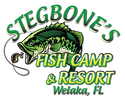Freshwater Fishing in Putnam County Florida
St. Johns River
This unique Florida river flows 300 miles north from its origin near Lake Blue Cypress west of Vero Beach to the Atlantic Ocean beyond Jacksonville. Its flow is sluggish because waters at its source lie less than 20 feet above sea level, creating a gentle gradient throughout its run. The St. Johns is dependent upon rain-fall for its flow, but is navigable nearly to its source, except in times of drought, when the upper section (south of Lake Harney) is almost dry. Near Jacksonville, the river is brackish and fresh- freshwater species are not available; however, saltwater fishing opportunities include croaker, trout, redfish, flounder and shrimp. The remainder of the river southward towards its headwaters offers most of Florida’s freshwater sportfishes including largemouth bass, bluegill, redear sunfish, black crappie, striped bass, channel catfish and the seasonally migratory American shad. (A recreational saltwater fishing license is required to harvest American shad and other saltwater species.)
Crescent Lake
This 15,960-acre lake is connected to the St. Johns River via Dunns Creek, and offers excellent largemouth bass and black crappie fishing. Catching bass is best in the springtime near eelgrass beds, and in the fall near docks and structures. Bass often congregate around deeper docks and pilings where depth is more than 3 feet. Fishing is best using live shiners and artificial baits including plastic worms, spinnerbaits, and jerk-baits.
Lake Ocklawaha (Rodman Reservoir)
Situated east of Gainesville and south of Palatka, this world famous lake covers 9,500 acres of prime fishery habitat. Since its creation in 1968, Rodman Reservoir has been known for trophy largemouth bass, bluegill, black crappie and redbreast sunfish. Much of the fisheries’ success is due to abundant habitat in the form of stumps and aquatic vegetation, along with periodic lake drawdowns. Rodman Reservoir is ranked as one of the top largemouth bass lakes in Florida and the state’s largest bass of 2000 (15 and 17 pounds) came from the reservoir during March. Largemouth bass are most active during cooler months. Anglers targeting trophy largemouth bass use golden shiners either fished under a cork or free-lined. Most big bass are caught in the pool area, known as the “stump fields,” along the river channel. However, many trophy bass come from the area between Cypress Bayou and Kenwood Landing, including Orange Springs. Successful anglers also use artificial lures such as deep-diving and lipless crankbaits, spinnerbaits and soft plastics. Black crappie fishing can be good throughout the year, but peaks in January, February, and March. Bluegill and redear sunfish generally are caught from April through August. During these months, look for patches of floating vegetation in the flooded trees, rake small holes in the vegetation and drop down a hook baited with grass shrimp. Bends in the river channel also produce nice catches of bluegill and redear sunfish. The area between Orange Springs and Kenwood Landing is a best bet. Anglers targeting redbreast (redbellies) and spotted sunfish (stump- knockers) should focus on the river section of Rodman Reservoir (upstream of Cypress Bayou). Worms or small beetle spins fished in either deep holes or along the trees will produce nice catches of these tasty fish. Marion County access is from Eureka East and West recreation areas off CR 316, the Orange Springs Recreational Area, Cypress Bayou, and Hog Valley Ramp on NE 245th Ave. Rd.
Lake George
This 46,000-acre lake on the St. Johns River has been touted as the premier large- mouth bass fishing lake in central Florida. It has extensive vegetation that provides excellent habitat for bass, bluegill and redear sunfish. Little Lake George, downstream of Lake George, is the site of a sub-surface spring called the Croaker Hole that provides fast and furious striper fishing from May through September. For largemouth bass, use live shiners and artificial baits near the eelgrass beds and deeper pilings. The area near the mouth of Silver Glen Springs Run is popular with bass anglers. Live shad and grass shrimp fished near the jetties when the river is flowing should produce catches of largemouth bass, sunshine bass and small stripers. Striped bass anglers also may find the Navy bombing targets productive. Popular black crappie fishing areas are Willow Cove and the sunken barge at the center bombing target. Live minnows are the bait of choice. For stripers and sunshine bass, grass shrimp are the most popular bait used. The mouths of Silver Glen and Salt Springs may provide some early morning and late evening action during warm water times of the year.

